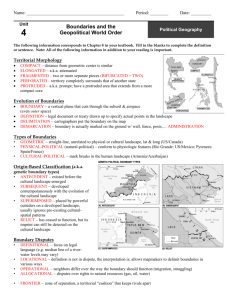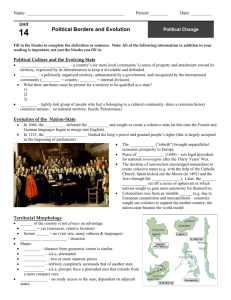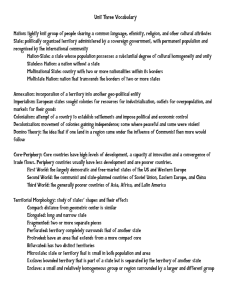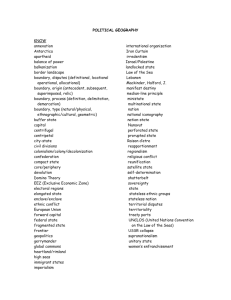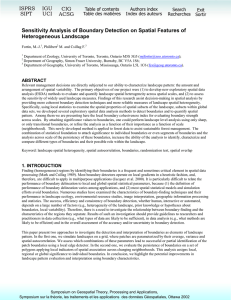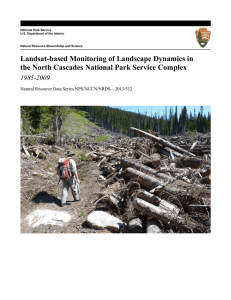File
advertisement
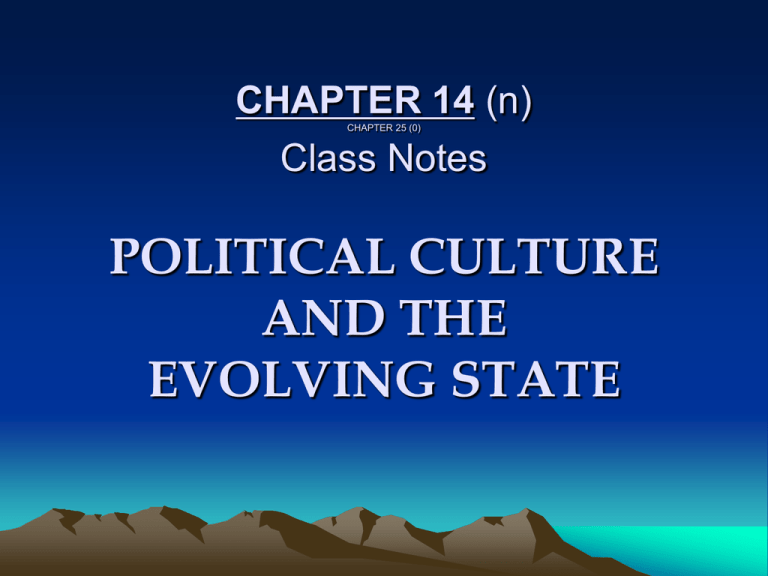
CHAPTER 14 (n) Class Notes CHAPTER 25 (0) POLITICAL CULTURE AND THE EVOLVING STATE • POLITICAL GEOGRAPHY – • study of the political organization of the planet • ??? • POLITICAL CULTURE – • Governing Ideal shared by the community How We Divide the World • Land divided into about 200 states • Modern State system from European Roots (pg. 207) • Key facets… •NATION – •People who share common historic, ethnic, cultural, religious views • Belong to community •Perceptual Element involved • Nation exists cause you think it does • STATE – • A Politically organized area (internationally recognized borders) • Very few true Nation-States • WHY??? The “Nation-State” • The aspiration of Governing elites • Nation and state occupy the same area • SOVEREIGNTY – • final authority of a state’s political, social, economic, military affairs rests with that state See the Difference • FRANCE – State > Identified political area Nation > Most people in France ID as French • YUGOSLAVIA – State > ID’d political area NOT A NATION > ID’d selves as Croatian, Serbian, etc.Not as Yugoslav Stateless Nations • Until 1948, Jewish nation had no state • Palestinians a nation, but have no state • Kurds in N. Iraq – nation of people, call land “Kurdistan” – But officially in Iraq / Turkey (see map pg. 200) Switzerland Bucks the Trend • Strong state, but many different people (French, German, Belgian, Italian) hard to ID as Swiss • Twist on Nation-State concept: – community committed to common political culture (the state ideal) – forgoes cultural assertion • USA SPATIAL CHARACTERISTICS OF STATES • No state exists without territory • Territorial Morphology – • Size, Shape, Relative location of States • Study dis / advantages of states / features I. SIZE • Big countries – USA > advantage USSR > disadvantage • Microstates – Extremely small states - Liechtenstein, Andorra, San Marino, Singapore II. SHAPE 1. COMPACT – (Most) Geometric center to any border point pretty even 2. FRAGMENTED – State in 2 or more pieces 3. ELONGATED – Thin, narrow, stretched out 4. PRORUPT (Protruded) – Extension out of compact core 5. PERFORATED – Country with another separate state within it ??? ??? !!! III. RELATIVE LOCATION • LANDLOCKED – Surrounded by other lands, no sea / ocean access • EXCLAVE / ENCLAVE • DEFENSE • RESOURCES • TRANSPORTATION BOUNDARY • Not just a line on the ground • Vertical Plane (diagram pg. 212) • Cuts deep into the ground and far up into the air • Rights to drill oil, mine coal / airspace Evolution of Boundary (3 stages) • 1. DEFINITION – • treaty-like definition on the landscape agreed upon • 2. DELIMITATION – • Put line on the map officially • 3. DEMARCATION – • Making the Boundary known – fences, markers, signs • FRONTIER – • Territorial cushion which keeps rivals apart Types of Boundaries • GEOMETRIC – • Lines, unrelated to physical landscape • PHYSICAL (Natural) POLITICAL – • Using natural landscape (A river) • CULTURAL POLITICAL – • Cultural breaks in the landscape (language, religion) Inter-Faith Boundary!!! Richard Hartshorne Origin (Genetic) Boundary Classification • Antecedent – • Existed before settlement occurred Example: ? • 49th parallel separating the U.S. and Canada. • Relic – • Ceased to function • Still can be detected on the cultural landscape. Example: ? • The Berlin Wall • • • • Subsequent – Established after the settlement Accommodate cultural differences Adjusted as the cultural landscape changes. Example: ??? • Former Yugoslavia Countries • • • • Superimposed – Imposed on an area by a conquering power Ignores existing cultures Satisfy demands of the superpower. Example: ??? • The division of African countries by the British. Boundary Disputes 1. Locational – interpretation of where boundary is actually drawn 2. Operational – how the border should function (controlling migration / immigration) • 3. Allocational – • Who has the rights to a resource • 4. Definitional – • focus on legal language of agreement • Put it all together… it’s a L.O.A.D.!
